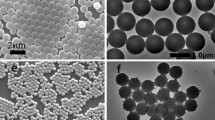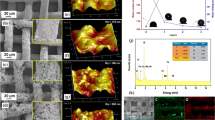Abstract
A facile and low-cost method based for tension gradient self-assembly was developed to prepare polytetrafluoroethylene (PTFE) nanofiber coatings on stainless-steel fiber felts. The PTFE particles were used as building blocks and the self-assembly process was analyzed thoroughly. After being sintered, the PTFE particles were transformed into PTFE nanofibers. The felts coated with the PTFE nanofibers exhibited super-hydrophobicity and superoleophilicity, and could separate a series of oil–water mixtures with high efficiency and good reusability. The coated felts also presented excellent chemical and thermal stabilities. Over all, this approach could easily fabricate ultra-robust oil–water separation materials suitable for industrial applications.




Similar content being viewed by others
References
Y. Yu, H. Chen, Y. Liu, V.S. Craig, C. Wang, L.H. Li, and Y. Chen: Superhydrophobic and superoleophilic porous boron nitride nanosheet/polyvinylidene fluoride composite material for oil‐polluted water cleanup. Adv. Mater. Interfaces 2, 1400267 (2015).
G. Kwon, E. Post, and A. Tuteja: Membranes with selective wettability for the separation of oil–water mixtures. MRS Commun. 5, 475 (2015).
Z. Xue, Y. Cao, N. Liu, L. Feng, and L. Jiang: Special wettable materials for oil/water separation. J. Mater. Chem. A 2, 2445 (2014).
K. Yin, D. Chu, X. Dong, C. Wang, J.-A. Duan, and J. He: Femtosecond laser induced robust periodic nanoripple structured mesh for highly efficient oil–water separation. Nanoscale 9, 14229 (2017).
J. Song, S. Huang, Y. Lu, X. Bu, J.E. Mates, A. Ghosh, R. Ganguly, C.J. Carmalt, I.P. Parkin, W. Xu, and C.M. Megaridis: Self-driven one-step oil removal from oil spill on water via selective-wettability steel mesh. ACS Appl. Mater. Interfaces 6, 19858 (2014).
E. Wang, H. Wang, Y. Hu, Z. Liu, and Y. Zhu: Corrosion-resistant engineering superhydrophobic and superoleophilic bulk materials with oil–water separation property. J. Mater. Sci. 52, 7130 (2017).
S. Wang, Y. Song, and L. Jiang: Microscale and nanoscale hierarchical structured mesh films with superhydrophobic and superoleophilic properties induced by long-chain fatty acids. Nanotechnology 18, 015103 (2006).
L. Wang, S. Yang, J. Wang, C. Wang, and L. Chen: Fabrication of superhydrophobic TPU film for oil–water separation based on electrospinning route. Mater. Lett. 65, 869 (2011).
J. Zhang and S. Seeger: Polyester materials with superwetting silicone nanofilaments for oil/water separation and selective oil absorption. Adv. Funct. Mater. 21, 4699 (2011).
C. Du, J. Wang, Z. Chen, and D. Chen: Durable superhydrophobic and superoleophilic filter paper for oil–water separation prepared by a colloidal deposition method. Appl. Surf. Sci. 313, 304 (2014).
J. Wang, Z. Shi, J. Fan, Y. Ge, J. Yin, and G. Hu: Self-assembly of graphene into three-dimensional structures promoted by natural phenolic acids. J. Mater. Chem. 22, 22459 (2012).
C. Chen, C. Du, D. Weng, A. Mahmood, D. Feng, and J. Wang: Robust superhydrophobic polytetrafluoroethylene nanofibrous coating fabricated by self-assembly and its application for oil/water separation. ACS Appl. Nano Mater. 1, 2632 (2018).
A.B. Artyukhin, O. Bakajin, P. Stroeve, and A. Noy: Layer-by-layer electrostatic self-assembly of polyelectrolyte nanoshells on individual carbon nanotube templates. Langmuir 20, 1442 (2004).
V. Tsukruk, V. Bliznyuk, D. Visser, A. Campbell, T. Bunning, and W. Adams: Electrostatic deposition of polyionic monolayers on charged surfaces. Macromolecules 30, 6615 (1997).
H.-H. Lu, Y.-M. Yang, and J.-R. Maa: Effect of artificially provoked Marangoni convection at a gas/liquid interface on absorption. Ind. Eng. Chem. Res. 35, 1921 (1996).
Y. Sha, H. Chen, Y. Yin, S. Tu, L. Ye, and Y. Zheng: Characteristics of the Marangoni convection induced in initial quiescent water. Ind. Eng. Chem. Res. 49, 8770 (2010).
N.O. Young, J.S. Goldstein, and M.J. Block: The motion of bubbles in a vertical temperature gradient. J. Fluid Mech. 6, 350 (1959).
D. Feng, D. Weng, and J. Wang: A facile interfacial self-assembly of crystalline colloidal monolayers by tension gradient. Micromachines (Basel) 9, 297 (2018).
Z. Luo, Z. Zhang, L. Hu, W. Liu, Z. Guo, H. Zhang, and W. Wang: Stable bionic superhydrophobic coating surface fabricated by a conventional curing process. Adv. Mater. 20, 970 (2008).
Z. Luo, Z. Zhang, W. Wang, W. Liu, and Q. Xue: Various curing conditions for controlling PTFE micro/nano-fiber texture of a bionic superhydrophobic coating surface. Mater. Chem. Phys. 119, 40 (2010).
W. Zhang, N. Liu, Y. Cao, Y. Chen, L. Xu, X. Lin, and L. Feng: A solvothermal route decorated on different substrates: controllable separation of an oil/water mixture to a stabilized nanoscale emulsion. Adv. Mater. 27, 7349 (2015).
A. Accardo, V. Shalabaeva, E. Di Cola, M. Burghammer, R. Krahne, C. Riekel, and S. Dante: Superhydrophobic surfaces boost fibril selfassembly of amyloid β peptides. ACS Appl. Mater. Interfaces 7, 20875 (2015).
Z. Xue, Z. Sun, Y. Cao, Y. Chen, L. Tao, K. Li, L. Feng, Q. Fu, and Y. Wei: Superoleophilic and superhydrophobic biodegradable material with porous structures for oil absorption and oil–water separation. RSC Adv. 3, 23432 (2013).
P. Pi, K. Hou, C. Zhou, G. Li, X. Wen, S. Xu, J. Cheng, and S. Wang: Superhydrophobic Cu2S@Cu2O film on copper surface fabricated by a facile chemical bath deposition method and its application in oil–water separation. Appl. Surf. Sci. 396, 566 (2017).
S. Yu and Z. Guo: Superhydrophobic surfaces based on polypyrrole with corrosion resistance and the separation of oil/water mixture properties. RSC Adv. 5, 107880 (2015).
P. Roach, N.J. Shirtcliffe, and M.I. Newton: Progress in superhydrophobic surface development. Soft Matter 4, 224 (2008).
Z. Bi and D.W. Mueller: Friction predication on pin-to-plate interface of PTFE material and steel. Friction, Published online 10 August 2018.
I.S. Bayer, A.J. Davis, E. Loth, and A. Steele: Water jet resistant superhydrophobic carbonaceous films by flame synthesis and tribocharging. Mater. Today Commun. 3, 57 (2015).
I. Bayer, V. Caramia, D. Fragouli, F. Spano, R. Cingolani, and A. Athanassiou: Electrically conductive and high temperature resistant superhydrophobic composite films from colloidal graphite. J. Mater. Chem. 22, 2057 (2012).
Acknowledgment
This research was funded by the National Natural Science Foundation of China (Grant Nos. 51775296, 51375253, 51703116, and 20171301886). The authors also acknowledge the support of this work from the State Key Laboratory of Tribology, Tsinghua University, China, under grant codes SKLT2017C06 and SKLT2018C06.
Author information
Authors and Affiliations
Corresponding author
Supplementary material
Supplementary material
The supplementary material for this article can be found at https://doi.org/10.1557/mrc.2019.65
Rights and permissions
About this article
Cite this article
Feng, D., Weng, D., Chen, C. et al. Tension gradient self-assembly to facilely fabricate polytetrafluoroethylene coatings for oil–water separation. MRS Communications 9, 690–696 (2019). https://doi.org/10.1557/mrc.2019.65
Received:
Accepted:
Published:
Issue Date:
DOI: https://doi.org/10.1557/mrc.2019.65




